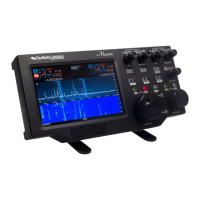FLEX-6000 Signature Series - SmartSDR for Windows Software User’s Guide
Page 88
Copyright 2018 FlexRadio Systems. All Rights Reserved.
The columns are defined as follows:
• Owner - This is important for importing files and is typically the callsign of the person creating
the memory. This will be populated automatically when creating a new memory if a callsign
has been entered in SmartSDR.
• Group - Also important for importing. The combination of Owner/Group identifies a set for
import. When importing, the existing Owner/Group memories will be removed prior to
importing the new fields. This makes it easy for a user to keep a master list of memories and
distribute them and not have to worry about merging existing old data - initially blank
• Freq - The frequency to tune the slice when selecting the memory. This will initially be set
to the Active Slice frequency when adding a memory.
• Name - A unique name for this memory - Initially blank.
• Mode - The Modulation/Demodulation mode for the slice (e.g. USB, CW, FM, etc.). Initially
set to the Active Slice mode.
• OffsetDirection - If in FM mode, this sets the direction for the repeater transmitter offset.
Options are Down, Simplex and Up. Initially this will be set to the matching setting in the
Active Slice.
• RepeatersOffset - The offset in MHz. Initially this will be set to the matching setting in the
Active Slice.
• ToneMode - In FM transmit, this can be set to Off or CTCSS TX for PL tones. Initially this will
be set to the matching setting in the Active Slice.
• ToneValue - The tone value in Hz to use for CTCSS TX
• Squelch – Turns FM Squelch on or off.
• Squelch Value – The Squelch threshold value.
• RF Power - The power setting from 0-100 to use for this memory.
• RXFilterLow - The Receive Filter Low Cut in Hz
• RXFilterHigh - the Receive Filter High Cut in Hz
• RTTY Mark - The mark frequency when using RTTY mode
• RTTY Shift - The shift frequency when using RTTY mode
• DIGL Offset - The offset when using DIGL mode
• DIGU Offset - The offset when using DIGU mode

